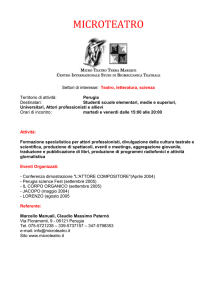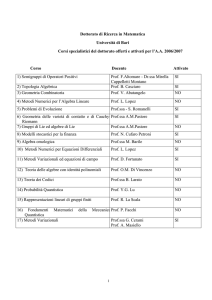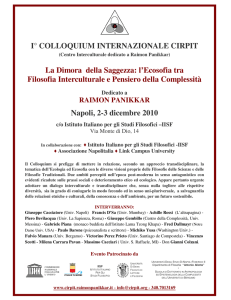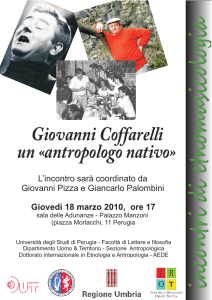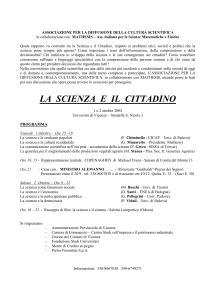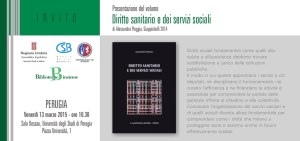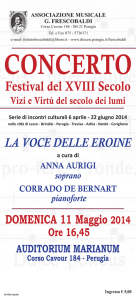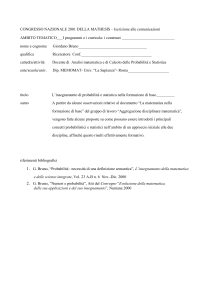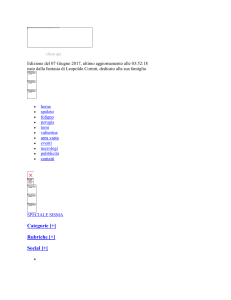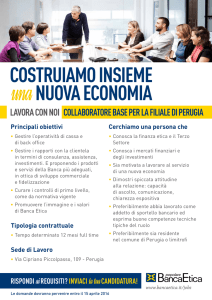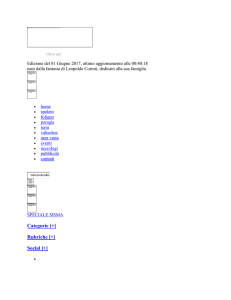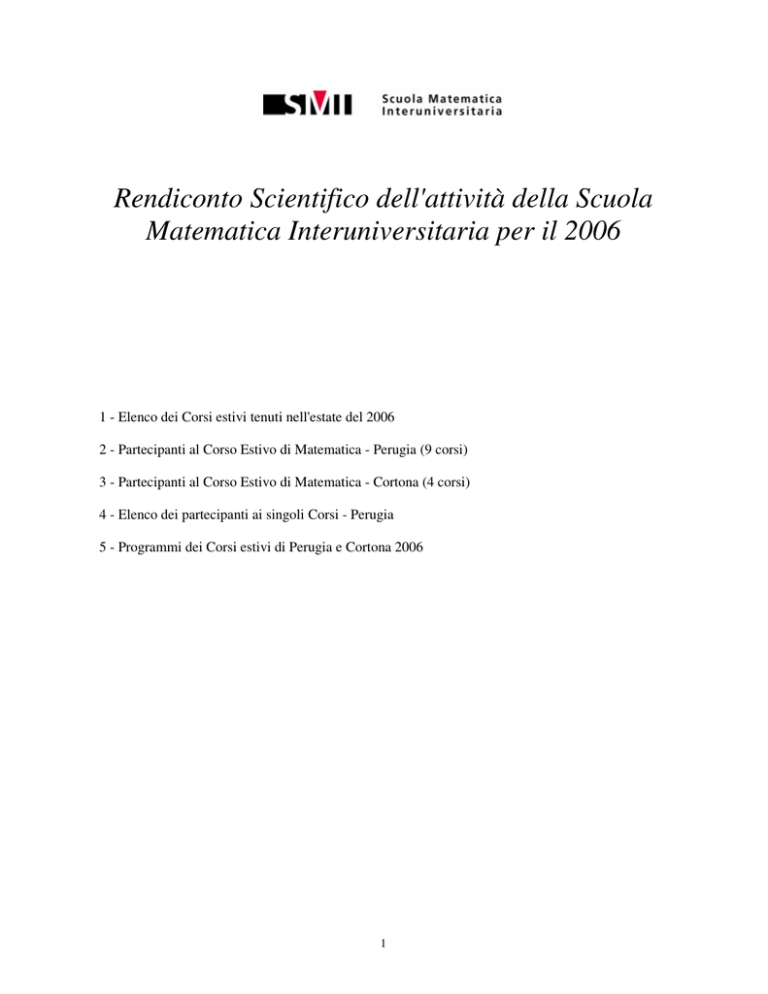
Rendiconto Scientifico dell'attività della Scuola
Matematica Interuniversitaria per il 2006
1 - Elenco dei Corsi estivi tenuti nell'estate del 2006
2 - Partecipanti al Corso Estivo di Matematica - Perugia (9 corsi)
3 - Partecipanti al Corso Estivo di Matematica - Cortona (4 corsi)
4 - Elenco dei partecipanti ai singoli Corsi - Perugia
5 - Programmi dei Corsi estivi di Perugia e Cortona 2006
1
Rendiconto scientifico dell'attività della SMI per il 2006
Nell'estate 2006 la Scuola Matematica Interuniversitaria, con la collaborazione della Scuola
Normale Superiore di Pisa e del Dipartimento di Matematica dell'Università di Perugia, ha
organizzato corsi di base per laureandi e giovani laureati nella sede di Perugia e corsi più avanzati,
di avviamento alla ricerca a Cortona.
1 - ELENCO DEI CORSI ESTIVI TENUTI NELL'ESTATE DEL 2006
PERUGIA: (30 luglio –2 settembre)
Insegnamenti
- Algebra
Alberto Facchini, Univ. Padova
- Analisi Complessa
Edgar Lee Stout, Univ. Washington Seattle.
- Analisi Funzionale
Eric T. Sawyer, McMaster Univ.
- Analisi Numerica
Christian Lubich, Univ. Tuebingen
-Equazioni differenziali
della Fisica Matematica
Guido Sweers, TU Delft
- Geometria Algebrica
Marco Andreatta, Univ. Trento
- Geometria Differenziale
Gudlaugur Thorbergsson, Univ. Koeln
- Probabilità
Giovanni Pistone, Politecnico Torino
- Teoria dei Modelli
Zachary Scott, East Carolina Univ.
CORTONA I:2 – 14 luglio 2006
- Syzygies, Hilbert functions generic initial ideals : Aldo Conca, Univ. Genova
Juan C. Migliore, Univ. Notre Dame-Indiana
CORTONA II: 2 – 23 luglio 2006
- A Geometrial Approach to Free Boundary Problems : Luis A. Caffarelli, Univ. Texas
Sandro Salsa, Politecnico Milano
CORTONA III:23 luglio – 12 agosto 2006
- Mathematical Finance
Wolfgang Runggaldier, Univ. Padova
Uwe Schmock, Wien Univ. Technology
CORTONA IV:30 luglio – 19 agosto 2006
- Morse Theory Application to Diferential
Geometry and onedimensional variational Problems : Francesco Mercuri, Univ.Campinas,
Paolo Piccione, Univ.Camerino e Univ.
San Paolo
2
2 – PARTECIPANTI AL CORSO ESTIVO DI MATEMATICA – PERUGIA (9 corsi)
July 30 – September 2, 2006
Studenti Italiani
Domande:
Studenti ammessi:
Partecipanti effettivi:
110
102
81
Studenti stranieri
Domande:
75
Studenti ammessi: 38
Partecipanti effettivi:31
3 –PARTECIPANTI AL CORSO ESTIVO DI MATEMATICA – CORTONA (4 CORSI)
3a) - CORTONA: 2 luglio – 14 luglio, 2006
Elenco dei partecipanti ai singoli corsi
- Syzygies, Hilbert functions generic initial ideals
Partecipanti Italiani
Domande :
10
Studenti ammessi: 9
Partecipanti effettivi: 8
BENEDETTI Beatrice
BERTELLA Valentina
GRIECO Elena
GUERRINI Eleonora
LA BARBIERA Monica
MALASPINA Francesco
SOMONETTI Ilaria
SORRENTI Loredana
Perugia
Genova
L’Aquila
Pisa
Messina
Torino
Pisa
Messina
3
Partecipanti Stranieri
Domande :
Studenti ammessi :
Partecipanti effettivi :
13
13
11
CIMPOEAS Mircea
CONSTANTINESCU Alexandru
COOPER Susan Marie
KAMPF Gesa
OLLER MARCEN Antonio M.
OSTAFE Lavinia
SECELEANU Alexandra
SOGER Christof
STAMATE Dumitru
STOKES Erik
WIBMER Michael
Bucharest
Bucharest
Queen’s (Canada)
Osnabruck
Zaragoza
Bucharest
Bucharest
Osnabruck
Bucharest
entucky
Innsbruck
3b) – CORTONA: 2 luglio – 22 luglio
A Geometrial Approach to Free Boundary Problems
Studenti Italiani
Domande :
Studenti ammessi:
Partecipanti effettivi:
14
14
13
Elenco dei partecipanti ai singoli corsi
ANTONANGELI Giorgio
ANTONELLI Paolo
ARGIOLAS Roberto
AROSIO Leandro
CASTELPIETRA Marco
CECCHINI Simone
CESERI Maurizio
CIRAOLO Giulio
DI NARDO Rosaria
GAVITONE Nunzia
NORIS Benedetta
PATRIZI Stefania
PERROTTA Adamaria
Roma La Sapienza
L’Aquila
Cagliari
Pisa
Roma To Vergata
Firenze
Firenze
Firenze
Napoli
Napoli
Milano Bicocca
Perugia
Napoli
4
Studenti stranieri
Domande:
Studenti ammessi:
Partecipanti effettivi:
14
14
12
ARAMA Danut
CIOMAGA Adina G.
GRIGORIU Andreea G.
HILLERMAA Kadri
HITZAZIS Iasonas
IBRAHIM Hassan
MARTINEZ Sandra
MILBERS Zoja
OLECH Michal
PAVLICEK Libor
SYLWESTRZAK Ewa
VARVARUCA Eugen
Al. I. Cuza
Al. I. Cuza
Al. I. Cuza
Tartu
Patras
Liban
Buenos Aires
Koeln
Wroclaw
Praga
Zielona Gora
Al. I. Cuza
3c) – CORTONA: 23 luglio – 12 agosto 2006
Mathematical Finance
Studenti Italiani
Domande :
Studenti ammessi :
Partecipanti effettivi:
18
18
16
Elenco dei partecipanti ai singoli corsi
ACCIAIO Beatrice
BLASI Francesco
D’AMICO Guglielmo
D’IPPOLITI Fernanda
D’URZO Eleonora
FEDELE Mariagrazia
FEDERICO Salvatore
FERRETTI Camilla
GIULIETTI Paolo
GOBBI Fabio
LOMBARDI Luana
MASTROLEO Marcello
MERCURI Lorenzo
PREZIOSO Valentina
Perugia
Roma La Sapienza
Chieti
L’Aquila
Perugia
Bari
Pisa
Firenze
Pisa
Firenze
L’Aquila
Perugia
Ancona
L’Aquila
5
RUSSO Emilio
VALENTE Carla
Calabria
L’Aquila
Studenti stranieri
Domande :
Studenti ammessi:
Partecipanti effettivi:
14
13
11
DENIZ Asli
DENGLER Barbara
GEVEILERS Vjaceslavs
HUNT Julien
MAKAR Nadyia
RAFLER Mathias
RENZ Norbert
VAJDA Istvan
VANDAELE Nele
ZAKHAROVA Anastasia
XU Ling
Izmir Institute Technology
Vienna
Hamburg
Catholique de Louvaine
Lviv
Postdam
Ulm
Corvinus Budapest
Gent
Mosca
Leipzig
3d) – CORTONA: 30 luglio – 19 agosto 2006
Morse Theory, Application to Differential Geometry and One-dimensional variational
Problems
Studenti Italiani
Domande:
Studenti ammessi:
Partecipanti effettivi:
7
7
7
Elenco dei partecipanti ai singoli corsi
DE LEO Barbara
GAZZINI Marita
MACIOCCO Giovanni
RINALDELLI Mauro
ROSATI Lilia
SANTI Andrea
SICILIANO Gaetano
Lecce
Milano
Cagliari
Firenze
Firenze
Firenze
Bari
6
Studenti stranieri
Domande:
Studenti ammessi:
Partecipanti effettivi:
6
6
4
ABARDIA BOCHACA Judit
BALMUS Adina
CEBANU Radu
POCOVNICU Oana
Autonoma Barcelona
Al. I. Cuza
Bucharest
Al. I. Cuza
4 - ELENCO DEI PARTECIPANTI DEI SINGOLI CORSI DI PERUGIA
Algebra – (27)
Studenti Italiani
BENEDETTI Bruno
BOVENZI Michele
CASPANI Luigi
CIGOLI Alan Stefano
DI MARIA Giovanni
FINOCCHIARO Carmelo Antonio
GALETTO Federico
GENTILE Tommaso
IMPERATORE Diana
MESSINA Simona
MORINI Francesco
POVERO Masismiliano
RAGUSA Giorgio
REDUZZI Davide
TARASCA Nicola
TEDESCO Giovanna
TERRAGNI Tommaso
VENEZIANO Francesco
Genova
Napoli
Como Insuria
Milano
Napoli
Catania
Torino
Calabria
Salerno
Catania
Messina
Torino Politecnico
Catania
Milano
Roma Tor Vergata
Napoli
Milano
Pisa
Studenti stranieri
COPIL Vlad Alexandru
CRONIN Anthony
DEMIRCI Yilmaz Mehmet
FERAGEN Aasa
LICHIARDOPOL Elena-Raluca
PETRISAN Daniela-Luana
PORUMBEL Daniel Cosmin
TOP Serpil
WALTON Chelsea
Bucharest
National Univ. Ireland
Izmir Inst.
Helsinki
Bucharest
Bucharest
Bucharest
Izmir Inst.
Michigan State Univ.
7
Analisi Complessa – (22)
Studenti Italiani
ARLOTTO Alessandro
BOCCIA Serena
BOCHICCHIO Ivana
CERREIA VIOGLIO Simone
GALETTO Federico
GRANDI Stefania
MAININI Edoardo
PANICCIA Irene
Torino
Salerno
Salerno
Milano Bocconi
Torino
Bologna
Milano Politecnico
Roma La Sapienza
Studenti stranieri
BLAGA Camelia-Elena
BLANCO Ivan
BLASZKE Malgorzata
CAGATAY Filiz
COPIL Vlad-Alexandru
CRONIN Anthony
DUMITRU Dan
LICHIARDOPOL Elena-Raluca
MAINKA Ewelina
NOVIKOVA Anna
PUMPERLA Max
RAICU Claudiu Cristian
TACHE Alexandru-Petre
TYC Katarzyna
Bucharest
Complutense Madrid
Silesian
Izmir Inst.
Bucharest
National Univ. Ireland
Bucharest
Bucharest
Silesian
Voronezh
Kaiserslautern
Bucharest
Bucharest
Silesian
Analisi Funzionale - (16)
Studenti Italiani
BOCCIA Serena
CERREIA VIOGLIO Simone
CHIEPPA Loredana
DE FUSCO Rossella
DI MICHELE Federica
MAININI Edoardo
MERCURI Carlo
PANICCIA Irene
ROSSARO Pier Cristoforo
SELVITELLA Alessandro
TAVERNISE Marianna
Salerno
Milano Bocconi
Bari
Napoli
L’Aquila
Milano Politecnico
Milano
Roma La Sapienza
Torino Politecnico
Milano
Calabria
8
Studenti stranieri
DUMITRU Dan
NESIC Svetozar
REMUS Radu
TACHE Alexandru-Petre
TANASE Raluca
Bucharest
Belgrado
Bucharest
Bucharest
Bucharest
Analisi Numerica - (17)
Studenti Italiani
BERNARDI Mauro
CHIEPPA Loredana
DE ANGELIS Guido
FELACO Elisabetta
FLERES Mirko
GAETANO Raffaele
GRANDI Stefania
LABITA Marzia
TAVERNISE Marianna
UBERTINI Filippo
Venezia
Bari
Perugia
L’Aquila
Bologna
Napoli
Bologna
Como Insubria
Calabria
Perugia
Studenti stranieri
CARDENAS PRIETO Ernesto Adolfo
DE KORT Johan Peter
GALAN Ioana-Catalina
GOUIN Cindy
NOVIKOVA Anna
PRYER Tristan
SAVA Ecaterina
Externado Colombia
Delft
Al.I. Cuza
Debureaux
Voronezh
Sussex
Al.I. Cuza
Equazioni Differenziali della Fisica Matematica – (17)
Studenti Italiani
BOCHICCHIO Ivana
CAVALETTI Fabio
DE ANGELIS Guido
DI MICHELE Federica
FELACO Elisabetta
MARI Luciano
MERCURI Carlo
SELVITELLA Alessandro
UBERTINI Filippo
Salerno
Roma La Sapienza
Perugia
L’Aquila
L’Aquila
Milano
Milano
Milano
Perugia
9
Studenti stranieri
BEREZOVSKA Ganna
CAGATAY Filiz
DE KORT Johan Peter
GOUIN Cindy
NESIC Svetozar
PILARCZYC Dominika
PRYER Tristan
TACHE Alexandru-Petre
Kyiv National
Izmir Inst.
Delft
Duberaux
Belgrado
Wroclaw
Sussex
Bucharest
Geometria Algebrica - (27)
Studenti Italiani
CASPANI Luigi
CAVALLETTI Fabio
CHIECCHIO Alberto
GENTILE Maria
GENTILE Tommaso
IMPERATORE Diana
MAGGIOLO Stefano
POMA Flavia
POVERO Massimiliano
TARASCA Nicola
TERRAGNI Tommaso
VENEZIANO Francesco
VERONELLI Giona
VISCO COMANDINI Filippo
Como Insuria
Roma La Sapienza
Torino
Napoli
Calabria
Salerno
Ferrara
Pisa
Torino Politecnico
Roma Tor Vergata
Milano
Pisa
Como Insubria
Roma La Sapienza
Studenti stranieri
BLANCO Ivan
DE BALLE PIGEM Borja
DEMIRCI Yilamz Mehmet
FERAGEN Aasa
FLUCH Martin
PETRISAN Daniela Luana
PUMPERLA Max
RAICU Claudiu Cristian
REMUS Radu
TANASE Raluca
TOP Serpil
TYC Katarzyna
WALTON Chelsea
Complutense Madrid
Catalogna
Izmir Inst.
Helsinki
Ruprecht-Karls
Bucharest
Kaiserslautern
Bucharest
Bucharest
Bucharest
Izmir Inst.
Silesian
Michigan State
10
Geometria Differenziale – (10)
Studenti Italiani
BOCHICCHIO Ivana
FLERES Mirko
GENTILE Maria
MAGGIOLO Stefano
MARI Luciano
POMA Flavia
ROSSARO Pier Cristoforo
VERONELLI Giona
VISCO COMANDINI Filippo
Salerno
Bologna
Napoli
Ferrara
Milano
Pisa
Torino Politecnico
Como Insubria
Roma La Sapienza
Studenti stranieri
PILARCZYK Dominika
Wroclaw
Probabilità – (10)
Studenti Italiani
ARLOTTO Alessandro
BERNARDI Mauro
GAETANO Raffaele
LABITA Marzia
Torino
Venezia
Napoli
Como Insubria
Studenti stranieri
BEREZOVSKA Ganna
BLAGA Camelia-Elena
CARDENAS PRIETO Ernesto Adolfo
FLUCH Martin
GALAN Ioana-Catalina
SAVA Ecaterina
Kyiv National
Bucharest
Externado Colombia
Ruprecht Karls
Al. I. Cuza
Al. I. Cuza
Teoria dei Modelli – (15)
Studenti Italiani
BENEDETTI Bruno
BOVENZI Michele
CIGOLI Alan Stefano
DE FUSCO Rossella
DI MARIA Giovanni
FINOCCHIARO Carmelo Antonio
MESSINA Simona
MORINI Francesco
RAGUSA Giorgio
REDUZZI Davide
TEDESCO Giovanna
Genova
Napoli
Milano
Napoli
Napoli
Catania
Catania
Messina
Catania
Milano
Napoli
11
Studenti Stranieri
BLASZKE Malgorzata
DE BALLE PIGEM Borja
MAINKA Ewelina
PORUMBEL Daniel Cosmin
Silesian
Catalogna
Silesian
Bucharest
5 - PROGRAMMI DEI CORSI DI PERUGIA E CORTONA
12
Programmi Corso Estivo Perugia : 30 luglio agosto-2 settembre 2006
ALGEBRA
Docente: Prof. Alberto Facchini, Univ. Padova
Course contents
Rings and ring homomorpisms. Simple rings, division rings.
Modules and module homomorphisms. Direct sums, quotient modules. Isomorphism theorems.
Cyclic modules. Zorn's lemma. Exact sequences. Maximal submodules. Free modules, IBN rings.
Projective modules and their properties. Group rings. Simple modules, semisimple modules.
Composition series. Jordan-H\"older theorem. Artinian/noetherian modules and rings. Semisimple
artinian rings. Schur's lemma. The theorem of Artin-Wedderburn. Simple artinian rings. Faithful
modules, primitive rings, Chevalley-Jacobson theorem. Group representations. Maschke's theorem.
Hopkins-Levitzki's theorem. Jacobson radical. Hereditary rings. Dedekind domains. Local rings.
Injective modules. Baer's criterion. Every module can be embedded in an injective module.
Essential extensions.
Lezioni in Inglese
Prerequisites:
The basic definitions and the first elements of the theory of groups, rings, modules, and linear
algebra. Any student of Mathematics at the University, after three years of study, should know
them.
Textbook: Donald S.~Passman, ``A Course in Ring Theory'', AMS Chelsea Publishing, 2004.
ANALISI COMPLESSA
Docente: Prof. Edgar Lee Stout, Univ. of Washington Seattle, Washington
Programma:
1. The arithmetic and geometry of the complex plane.
2. Complex differentiation and the Cauchy-Riemann equations.
3. Elementary functions. Power series.
4. Complex integration. Cauchy's Theorem-the simplest case.
5. Elementary properties of holomorphic functions.
6. Infinite Products. The Blaschke condition.
7. More general versions of Cauchy's Theorem.
8. Residue theory and the evaluation of real integrals.
9. Conformal mapping. The automorphisms of the disc, the plane and the
sphere. Examples of mappings by elementary functions.
10. Normal families.
11. The Riemann Mapping Theorem.
12. Runge's Theorem. Applications.
Lezioni in Inglese
Prerequisiti: Elementary analysis at the level of Rudin's,Principals of Mathematical Analysis.
Testo: John B. Conway Functions of one Complex Variable I, Springer-Verlag
ANALISI FUNZIONALE
Course contents
Part I of the Text - especially chapters 2, 3, 4 and 5 – including Banach-Steinhaus theorem, open
mapping theorem, closed graph theorem Hahn-Banach theorem, Banach-Alaoglu theorem, KreinMilman theorem, holomorphic functions.
Duality, compact operators
Various applications to closed subspace of $L^p$ spaces, range of a vector valued measure,
Bishop's
theorem, interpolation theorems, fixed point theorems, Haar measure, and complemented
subspaces.
Time permitting, brief introductions to distributions and partial differential equations (Part II) and
spectral theory
of Banach algebras (Part III) will be given.
Lectures in English
Prerequisites: Lebesgue integration, completeness of $L^p$ spaces, elementary properties of
holomorphic functions.
A reference for the prerequisites topics is chapters 2, 3 and 10 of "Real and Complex Analysis" by
Walter Rudin,
McGraw Hill, Inc.
Textbook: "Functional Analysis" by Walter Rudin, McGraw Hill, Inc. 1991
ANALISI NUMERICA
Docente: Prof. Christian Lubich, Univ. Tuebingen
Course contents
The course will introduce into basic techniques and methods of Numerical Analysis. It will cover
the following topics:
1. Interpolation and approximation
(Polynomial interpolation by Newton's formula,
Errors in polynomial interpolation,
Chebyshev interpolation,
spline interpolation,
Numerical differentiation
2. Numerical integration
(Quadrature formulas, order and error,
Gaussian quadrature, adaptive quadrature)
3. Numerical solution of ordinary differential equations
(Basics, Runge-Kutta methods, extrapolation methods,
multistep methods)
Lezioni in Inglese
Testo : W. Gautschi, Numerical Analysis: An Introduction, Birkhaeuser 1997.
EQUAZIONI DIFFERENZIALI DELLA FISICA MATEMATICA
Docente : Prof. Guido Sweers, Universitaett zu Koeln and Delft University of Technology
Initial programme:
1. From models to differential equations
- Laundry on a line: a linear and a nonlinear model
- Flow through area and more 2d
- Problems involving time: Wave equation, Heat equation
- Differential equations from calculus of variations
- Mathematical solutions and `real life'
2. Spaces, Traces and Imbeddings
- Function spaces: Hoelder spaces, Sobolev spaces
- Restricting and extending, traces and corresponding Sobolev spaces
- Inequalities by Gagliardo, Nirenberg, Sobolev and Morrey
3. Some new and old solution methods I
- Direct methods in the calculus of variations
- Solutions in flavours
- Characteristics and local solutions by Cauchy-Kowalevski:
4. Some old and new solution methods II
- Special domains and almost explicit formula
- Weak solutions by Lax-Milgram
- The wave equation in 3 and 2 space dimensions
5. Some classics for a unique solution
- Energy methods
- Maximum principles
Lezioni in Inglese
Prerequisites: Analysis, Ordinary Differential Equations, and preferably some elementary
knowledge of Functional Analysis or Partial Differential Equations
Testo: Lawrence C. Evans, Partial differential equations. Graduate Studies in
Mathematics, 19. American Mathematical Society, Providence, RI, 1998.
GEOMETRIA ALGEBRICA
Docente: Prof. Marco Andreatta, Univ. Trento
Course contents
The course will introduce into the study of Riemann surfaces (Rs) and algebraic curves. The
prerequisites are some basic definitions of general topology and the first elements of the theory of
holomorphic functions of one complex variable.
1. Definitions, examples and constructions of Rs.
2. Functions and morphisms between Rs. Differential forms and integration on Rs.
3. Meromorphic functions and divisors on Rs. Morphisms and linear sysitems.
4. Riemann Roch theorem, Serre duality and applications.
Lectures in Italian/English
Textbook: Rick Miranda, Algebraic Curves and Riemann Surfaces, Am.Math.Soc.GSM vol.5
(1997)
GEOMETRIA DIFFERENZIALE
Docente: Prof. Gudlaugur Thorbergsson, Univ. Koeln
The aim of the course is to give an introduction to basic notions and
results of Riemannian Geometry.
Program:
Differentiable manifolds, Riemannian metrics, covariant derivatives, geodesics,
the curvature tensor, first and second variation formulas, Jacobi fields,
conjugate points, completeness, the theorem of Hopf-Rinow, the Theorems
of Hadamard and Bonnet-Myers
Lezioni in Inglese
Prerequisites:
Good knowledge of Multivariable Calculus and Linear Algebra will be assumed.
Some familiarity with the notion of a differentiable manifold will be helpful
Testo: Manfredo do Carmo, Birkheuser, 1992, Riemannian Geometry
PROBABILITA'
Docente: Prof. Giovanni Pistone, Politecnico di Torino
The plan is to cover as much as possible of the material contained in
the textbook J. Jacod & Ph. Protter, {Probability Essentials} 2nd Ed. Springer,
- Elementary probability (Ch. 2--5)
- Probability measures and random variables (Ch. 6--10)
- Probability distributions on real vector spaces (Ch. 11--16)
- Convergences and limit theorems (Ch. 17--21)
- Conditional expectation and martingales (Ch. 22--28)
The precise choice of topics will depend on the actual interests and
background of the students. Much room will be left to examples and
exercises.
TEORIA DEI MODELLI
Docente: Prof. Zachary Robinson, East Carolina University
Programma:
This is an introduction to model theory with applications to algebra and algebraic geometry. The
model theory is developed beginning with first-order languages and structures, theories and models,
definability and interpretability. Fundamental general techniques such as model-theoretic
compactness, completeness and back-and-forth constructions are introduced. The final segment
covers quantifier elimination for algebraically closed and real closed fields. Along the way,
applications to algebra and algebraic geometry will be discussed. These include Ax's theorem that
injective endomorphisms of complex algebraic varieties are surjective, Artin's solution to Hilbert's
17th Problem, Milnor's Curve Selection Theorem, and cell decomposition for real semi-algebraic
sets.
Lezioni in Inglese
Prerequisiti: A course in abstract algebra (properties of integers, polynomials, groups, rings, fields)
and minimal familiarity with logic (propositional calculus, predicate calculus, proof). To gain some
familiarity with logic, students with no prior experience might want to first look through a basic
logic text such as: the first half of "A Mathematical Introduction to Logic," by Herbert Enderton, or
the first quarter of "Mathematical Logic," by Ebbinghaus, Flum and Thomas.
Testo : "Model Theory: An Introduction," David Marker, Graduate Texts in Mathematics 217,
Springer-Verlag, New York, 2002 (ISBN: 0-387-98760-6).
Programmi Corso Estivo Cortona 2 luglio - 15 luglio 2006
Syzygies Hilbert Function and Generic Initial Ideas
Docente: Prof. Aldo Conca,Univ. di Genova
1) Introduction to the basic invariants: Hilbert functions, Betti numbers, regularity.
2) Initial ideals and deformations.
3) Monomial ideals, stable ideals, strongly stable ideals, Borel fixed ideals, lex-segments and more
generally tau-segments and their Betti numbers
4) Generic initial ideals: existence and main properties,
5) Polarizzation, distraction and gin.
6) Macaulay Theorem, Bigatti-Hullett and Pardue Theorem.
7) Rigidity: Herzog-Hibi-Aramova Theorem and extensions.
8) Froeberg conjcture, Gin of generic complete intersections. Anick's result.
9) Gin-lex
10) Simplical complexes, gin and shifting.
11) Regularity for powers
Libri consigliati :
- Bruns-Herzog "Cohen-Macaulay rings" Cambridge University Press, 1998.
- D.Eisenbud, "Commutative Algebra : with a View Toward Algebraic Geometry" Springer 1999.
Docente: Prof. Juan C. Migliore, Univ. Notre Dame, Indiana
1) Introduction (we will split the material )
2) Deficiency modules
3) Gorenstein ideals and subvarieties
4) Liaison 1
5) Liaison 2
6) Liaison 3
7) Froeburg conjecture (preparation for Conca's talk \#7)
8) Weak Lefschetz property
9) Multiplicity conjectures
10) Fat points
11) Tetrahedral curves
Programmi Corso Estivo Cortona 2 luglio - 23 luglio 2006
A Geometrical Approach to Free Boundary Problems
Docenti: Prof. Luis Caffarelli, Univ.Texas Austin-Prof. Sandro Salsa, Politecnico Milano
Course contents
Caffarelli and Salsa will coordinate their lectures to cover simultaneously the following topics:
Part I
The obastacle problem and flux-discontinuity type free boundary problems (one and two phases).
Introductory examples and problematic, the equations involved, variational and supersolution
approach. Global optimal regularity of solutions. Regularity and stability of interphases.
In the process, we develop the needed tools from geometric PDE: basic properties of solutions of
second order
elliptic equations in Lipschitz domains, interior and boundary harnack inequalities, monotonicity
formulas (about I and 1/2
weeks).
Part II
Extension of ideas and methods to other problems: twophase parabolic problems (Stefan type),
flow in
porus media, problems involving fractional laplacians (thin obstacles, Levy process).
Textbooks : L.A. Caffarelli, S.Salsa, A geometric approach to free boundary problems, A.M.S.
Providence, 2005.
The obstacle problem, Lezioni Fermiane, Pisa
Programmi Corso Estivo Cortona 23 luglio - 12 agosto 2006
Finanza Matematica
Docenti: Prof. Wolfgang J. Runggaldier, Univ. di Padova
Program :
[1.] Basic structure
1. Term structure of interest rates {\it (lectures and problem-solving sessions and
seminars)
2. Hedging of general claims by martingale representation (mainly
problem-solving sessions and seminars)
[2] Specific structure
Term structure of interest rates
- Basic concepts and preliminaries;
- Martingale models for the short rate and their calibration; Forward rate models {\it (HJM
framework)};
- Change of numeraire techniques;
- LIBOR and Swap market models
Remarks: The basic theory will be presented in a Brownian framework. As the lectures on the
general integration theory (Prof. Schmock) progress also settings beyond the Brownian
framework will be envisaged.
2. Hedging
After a short basic introduction during the lectures, this will be
mainly a topic for the problem-solving sessions and seminars. As
for the term structure, here too we shall start from a Brownian
framework that will then be gradually generalized in line with the
general integration theory (Prof. Schmock).
Lezioni in Inglese/Italiano
Testo :
T. Bjoerk, Arbitrage Theory in Continuous Time.
Oxford University Press 2004 (2nd edition).
Letture consigliate :
D.Brigo, F. Mercurio, Interest Rate Models – Theory and Practice. Springer Verlag 2005 (2nd
edition).
Possible additional material for lectures and problem-solving sessions and relating specific journal
articles will be made available on site.
Docente: Prof. Uwe Schmock, TU Wien
Motivation:
Let S denote a stochastic process describing the evolution of the discounted price of an asset, and
let H be the process describing the (possibly random) number of these assets at any given time in
the investor's portfolio. The gains and losses of this investment strategy H is given by the stochastic
integral of H with respect to S. It therefore lies at the heart of modern, continuous-time
mathematical finance to clarify, for which investment strategies H and price processes S this
stochastic integral is mathematically well defined and what its properties are.
Contents:
(I) We will follow the approach given in Ph. Protter's textbook, developing the theory of general
stochastic integration with respect to semimartingales, which includes the cases of Brownian
motion and Lévy processes. Applications of the theory, in particular to the modelling to the
stochastic evolution of the term structure of interest rates, will be given in Prof. Runggaldier's part
of the course. Ph. Protter's book contains an extensive list of exercises, which can be discussed in
the problem-solving sessions.
(II) Depending on time and interest of the course participants,
(a) credit risk modelling with an emphasis on CreditRisk+ and its extensions,
(b) properties of expected shortfall, and
(c) allocation of risk capital by expected shortfall will be treated in the seminars. Lecture notes
for preparing these seminars are available upon request.
Prerequisites:
Part (I) of the course requires familiarity with measure theoretic probability theory and basic
results about martingales, because these will be used without proofs. The textbook by D. Williams
and Chapter 2 of the textbook by S. Ethier and T. Kurtz are certainly a good source.
Lezioni in Inglese
Literature:
- Philip E. Protter: Stochastic Integration and Differential Equations, (2nd edition), Applications
of Mathematics: Stochastic Modelling and Applied Probability, Vol. 21, 2004, Springer-Verlag,
ISBN 3-540-00313-4.
- David Williams: Probability with Martingales, Cambridge Mathematical Textbooks, 1991,
Cambridge University Press, ISBN 0-521-40605-6
- Stewart N. Ethier and Thomas G. Kurtz: Markov Processes, Characterization and Convergence,
Wiley Series in Probability and Mathematical Statistics, 1986, John Wiley \& Sons, ISBN 0-47108186-8
- Uwe Schmock: Modelling Dependent Credit Risks with Extensions of CreditRisk+,
An Implementation-Orientated Presentation, Lecture Notes, 2006
(latest version available upon request, [email protected]).
Programmi Corso Estivo Cortona 30 luglio - 19 agosto 2006
Morse theory, with applications to Differential Geometry
Docenti: Prof. Francesco Mercuri (Unicamp) e Prof. Paolo Piccione (USP)
Short program of the course
First week:
- Review of Algebraic Topology.
- Ljusternik and Schnirelman theory.
- Classical Morse Theory.
Second week:
- Applications of the finite dimensional Morse Theory to submanifold theory: Generalized Gauss-Bonnet theorem, Chern-Lashof theorem, low codimensional submanifolds of positive curvature in
$R^N$, hyperplane section theorem.
- The Morse--Witten complex (in compact manifolds) and its homology.
Dynamical formulation of the Morse inequalities.
- Morse--Bott theory (critical submanifolds).
Third week:
- Some applications to Riemannian Geometry: The pinching Theorem, periodic geodesics, the
Yamabe problem.
- A strongly indefinite variational problem: Geodesics in Lorentzian manifolds, spectral flow,
Maslov index.
Basic bibliography:
1. Mercuri-Piccione-Tausk: {\it Morse Theory}, Published by I.M.P.A., Brazil, 2003.
2. Milnor: {\it Morse theory}, Annals of Math. Study, vol 51, Princeton University Press, 1963.
3. Palais-Terng: {\it Critical Point Theory and Submanifold Geometry}, Lectures Notes in Math.,
vol. 1353, Springer-Verlag, 1988.


